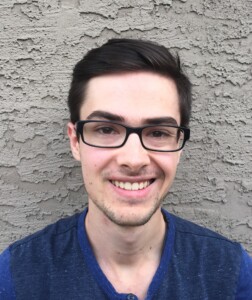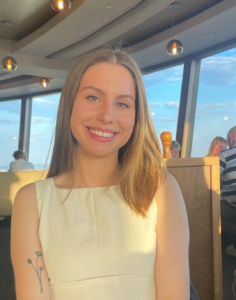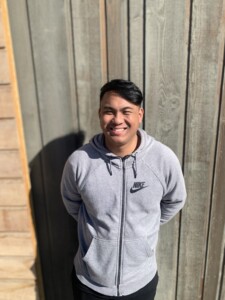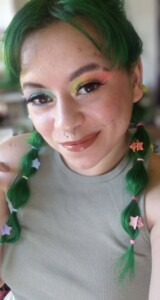From April 17 -18, we celebrated academic excellence at StMU by showcasing the final projects and presentations prepared by our fourth-year students during our 2023 Capstone Conferences. We’re excited to share the results of the hard work of our History students, who conducted their own research with the guidance of faculty supervisors.
The Feminine Mystique: Second Wave Feminism in Canada from the 1920s to the 1960s – Ashton McDonald

During my final year in my History degree I have learned to appreciate many of the complexities of history that still influence the modern day. I am excited to utilise this information in the future as I continue at St. Marys in the education program. I hope to apply the information I learned in the History program to my time in the Education program.
Project Abstract: Throughout my time in the St. Mary’s history program, I have enjoyed a large amount of classes on a variety of topics in regards to Canadian history. None of which have been as interesting to me as the History of Gender in Canada class. Through my studies I gained an appreciation of looking away from the biggest names in history such as prime ministers, instead looking towards those who were reported on much less in history. Instead looking towards the influence of specific cases that demonstrated how the average Canadian felt in certain times, not only what governmental figures felt was important. The under representation of women throughout a large majority of Canada’s history inspired my capstone project. Through my research I consider the concepts from Second Wave Feminism, and apply them to the social and political shifts that were occurring in the time following the First World War. My research aims to consider how these ideas of second wave feminism are effective or ineffective in describing the lives of Canadian women during the time, and examine the average Canadian citizen’s feelings with the changes that were occurring during these times of social and political change.
Alien Invaders: Communism, Labor disputes, and Uncle Sam in 1940s Hollywood – Benjamin Barrett

Though I am graduating at the end of this year with a major in History, it is perhaps my minor in Drama that better represents my interests. I have always loved stories, whether in massive epics such as Lord of the Rings, or in the smaller freshly imagined fairy tales given to me by older siblings. I find so much value in literature, art, music, television, and especially theatre. I think that telling stories is an intimately human expression, and for that reason I have always sought out history books and the stories they tell. There is value in the imagined worlds of fiction, but it is the actions of those in the past that to me have created the most enduring lessons and most important stories. In my personal life, It should come as no surprise that I love diving into the endless creative pursuits of humanity through reading books, watching television, playing videogames, and (admittedly poorly) playing music.
Project Abstract: Hollywood in the 1940s was a mix of creatively, financially, and politically motivated individuals working with and against one another to produce digestible films for America and abroad. In this complex landscape writers fought to produce meaningful art, producers fought to make money, and the government stepped in to sanitize and take advantage of the growing propaganda potential of film. My capstone looks at films from the era directly and peaks behind the curtain to see what troubles led to the creation of those films, and how those troubled years led to the formation of Hollywood as it functions today. Specifically, I look at how films from the later 1940s and early 1950s established a language of storytelling deeply intertwined with the Cold War “Us vs Them” mentality.
The Volga Germans – Braden Huck

Graduate of Lord Beaverbrook High School. Finishing a history degree with a focus on Eurasian history. Hoping to begin a teaching degree in the fall.
Project Abstract: The story of a peaceful people fleeing conscription and religious persecution in Russia only to fall into obscurity after their genocide.
Counter-narratives and Protest: The Impact of Letters to the Editor on Amplifying Marginalized Voices in Early Protest Movements and Royal Commissions in Canada

My experience at St. Mary’s has afforded me experiences and interpersonal relationships with staff that I would not have otherwise had at a larger institution. I have had the privilege of being a varsity athlete, on both the Cross-Country and Track teams. I joined the President’s Volunteer Team to be a partner in my community. As well, I have been encouraged to pursue my interests in women’s history through spirited discussions about the morality and reality of historical events and people. Finding women’s voices became a challenge and a form of representation for me. As I am the youngest of five girls, and my grandmother is the eldest of five girls, women have been my primary influences. Focusing on the 1960s protest movements in Canada shows the recent history of marginalized groups fighting for rights. This is an interesting period to study because there are more first-hand accounts by women, and of women excelling.
Project Abstract: Due to the social conventions of the time, topics of gender, race, religion, and politics were avoided in polite society; yet, between the 1930s and late 1950s, women and people of colour were writing letters to the editor to encourage community discourse regarding these issues. As letters to the editor were in response to another’s comments, people were able to converse about these taboo subjects. The mere existence of these letters shows the counternarrative to the post-war years of gender and race conformity. In the 1960s and 1970s, the government requested letters and briefs written by marginalized peoples, for Royal Commissions regarding underrepresented folk. An analysis of letters to the editor illuminates the significance of early advocates of social justice to the 1960s protest movements, and the methodology for, later, government reform tactics.
Nazi Germany’s Attempt at the Creation of their Perfect Race – Emily Edwards

I am graduating with my Bachelors of History with a Minor in Psychology. I have spent four years in St. Mary’s history program and have had the incredible opportunity to learn the history of the world. I feel privileged to have studied under professors who have shared classes with me from the ancient worlds transitioning into modern day cultures. I fell in love with not only learning about cultures past and present but the stories of great individuals and places.
Project Abstract: When looking into my interests within history as I picked a topic, I decided to focus on World War II. Yet I wanted to challenge myself and explore a topic I knew nothing about and begin from scratch. I ended up at Lebensborn, the German eugenics/breeding program. With my interests in World Wars, coupled with my family’s background, I began looking into Germany’s story of World War II from within. This began with the Hitler Youth programs and I accidently stumbled upon Lebensborn. With all of the reading and research I had done into World War II, I had never heard of the program. My hope with my capstone was to possibly teach others who may never have heard of it either. Finding testimonials from individuals who went through this program was where I committed to finding out more to the story. Behind the curtain of war, programs like Lebensborn have the opportunity to thrive with little to no attention. My capstone dives into the creation of the breeding program that was Lebensborn as well as the eugenics culture within Nazi Germany from the 1930’s to the effects which are still being felt today.
Classical Sparta: The Oikos and Religious Implications on the Militarism of the Polis

The field of classics has significantly influenced my direction of study from every possibility; I’ve strived to learn and understand more about the lives of the people of this ancient civilization. During my second year, I took a class on Greek and Roman History, a topic I was fascinated by due to my vast knowledge gained from modern media. Rick Riordan’s Percy Jackson from my childhood and Jennifer Saint’s Ariadne as recent. While the mass amounts of books surrounding classical religion do allow for more personal approaches to studying history, learning and being taught directly from historical sources was a dream come true. I found myself partial towards the Spartans, a unique civilization living within the Greek Peninsula; the notions of gendered divisions, childhood experiences, and the treatment or dehumanisation of the Enslaved Helot individual soon became topics that I stuck with until my final year. Since I could not take a single classics class these last semesters, I am happy to have focused on this topic for my capstone, as my love for Greek history has remained from childhood and will most certainly continue throughout my adult life.
Project Abstract: This presentation will focus around the Spartan Oikos, or household, and religious implications of specific dieties or figures on the developmental aspects of the military. The topics include stories, myths and factual based evidence that feature how these implications have impacted the Spartan system. My focus details aspects of motherhood, childhood development, relationships and abuse with the end goal of understanding daily life in the classical age. While this topic has morphed and changed while I fell down the research rabbit hole, my aim remained the same. Why was the military so crucial to the people? And why did every aspect of social life hold some type of involvement in strengthening the army?
Celtic Christianity: The Relationship Between Culture and Religion in the Early Middle Ages – Kailee Foggin

My interest in history began at a very young age but I never thought it would be what I would graduate University with a degree in. I have always found classical history to be the most interesting as it depicts a world so separate from the way we view it now but nevertheless innovative and evolutionary. My fascination with classical history was met with a desire to understand how religion and ancient faiths affected the way culture and society interacted and built itself up alongside the faiths followed at the time. This is where I got the inspiration for my capstone project.
Project Abstract: This presentation will explain the effects that the conversion and adoption of Christianity had on the culture and vice versa of the 5th through 8th century Celtic peoples of the British Isles. These peoples went from being pagan in all aspects of their life to adopting a form of Christianity that was based on Roman Catholicism, however; the product of the interactions between the deep-rooted Celtic ways of life and understanding of the world and the Roman Catholic faith caused a new product of Christianity to be born. By discussing the life and spirituality of the Celtic people prior to their conversion as well as who converted them, the influences that Roman Catholicism had, and the outcomes of the culture and spirituality well after the new faith was implemented, we will be exploring how and why what is known as Celtic Christianity is vastly different from traditional Catholicism. I will be using artifacts excavated throughout the High and Lowlands of the British Isles to visually show the timeline of this implementation. To conclude, I will discuss the relationship that culture and faith had at the end of the 8th century and the eventual equation of faith to culture that is so characteristic to Celtic Christianity of the time period.
Chasing the Ghosts of the Second-Hand Trade in Early Modern Europe: How Ordinary People Engaged with Luxury Textiles – Laura Gillis

Along with completing my degree in history, I minored in English. Both aspects of my degree have built critical and creative thinking skills, and the English education has particularly developed my creativity when examining primary sources and writing. Another major component of my degree was learning languages. I studied both Latin and French in my first year, and I use French on a daily basis with my partner. I enjoy taking courses in women’s history and studying marginalized groups. I have spent a lot of time, both for the purpose of class and personal interest, studying the history of dress in 17th-19th century Europe. In my personal life I enjoy cross country skiing, hiking, participating on a local swim team, and reading. I work as a lifeguard and swim instructor, as well as a peer tutor at St Mary’s.
Project Abstract: My presentation explores how luxury could be and was accessed by non-elites during the early modern period in Europe. Specifically, how ribbon was created and used by ordinary people despite legislation restricting what was worn. The primary source that I used was bog bodies; people who died and were preserved in the peat in bogs across northern Europe. These bodies are a time capsule of clothing and people. My capstone deals with the second-hand trade and how it was an access point for ordinary people to buy items they otherwise would not have contact with.
Vimy Ridge And The Formation of Canadian Identity – Ojoe Malabug

My name is Ojoe Malabug, and I am a graduate with an undergrad in history and hopes to further my post-secondary career in education. Growing up, my grandparents were both parents in the Philippines and I saw how much of an impact they had on their students. Years later I want to follow my grandparents’ footsteps and do so as teacher. The study of history as always fascinated me, learning about different times in history as well as different political ideology. The history program at St. Mary’s University has allowed me to expand my knowledge, in Canadian, and European history and my hopes is to share my knowledge as a teacher.
Project Abstract: The study of military studies has always fascinated me during my undergraduate degree. I found success learning about military formations, tactics, and weaponry. During my second year, I wrote a paper about the usage of the Lee-Enfield rifle that was used in the Boer War as well as the study of the nursing sister during the First World War. I found these topics fascinating and wanted to know more so I challenge myself to learn about Canadian military history. In the course of my research, I stumbled across a book called Vimy: The Battle and the Legend written by Tim Cook. What fascinated me about Vimy was that it was seen by some as the birthplace of Canadians. Furthermore, my research gave me a greater appreciation of the Vimy Memorial and how many political leaders such as Stephen Harper, Justin Trudeau, as well as the British monarchy all have made speeches at Vimy. My research has led me to the conclusion that the history of surrounding Vimy Ridge highlights Canadian Nationalism, which is forever symbolized in the Vimy Memorial.
The History of Sex Work as a Form of Women’s Liberation and Empowerment – Rebecca Skidmore

I have always been interested in different aspects of history and have spent the last five years of my life working on this degree. Throughout my time here I have discovered a great passion for women’s history as well as ancient history; one of the areas that has interested me greatly has been the history of sex work and the impact it has had on the lives of women in different civilizations. I plan to continue my studies focusing on women’s history and work towards broadening our understanding of the impact women have had on the world as we know it today.
Project Abstract: Sex work has existed since the dawn of civilization and has allowed people to make money and a career for themselves. Women have historically been heavily involved in the sex work industry and this has allowed them to work outside of societal expectations for people of their gender identity for centuries. This paper will explore the history of sex work in different areas of the world and its impact on both societal formations and women’s rights and liberation.
The History and Development of Post-Traumatic Stress Disorder in the Military – Tyson Foster

I am a History Major finishing my degree this Spring, I am very interested in European and Mediterranean History, and wanted to create a project that would reflect some of my main interests.
Project Abstract: Post Traumatic Stress Disorder is one of the most common illnesses a soldier can by diagnosed with while serving in the military, and the last 100 years has produced some of the most brutal and gruesome conflicts that have allowed for this illness to torment veterans on a scale never seen before. In this presentation, I want to explore and analyze how the perception and treatment of this illness has developed over the course of the last century, by discussing how PTSD was prevalent in both World Wars and The Vietnam War, and how modern day psychologists used lessons from the past to ensure this illness can be prevented or treated in Veterans from Afghanistan and Iraq. A large factor in the development of PTSD in soldiers, is the ethos that men should never speak about their own problems in order to avoid looking weak. This belief was present in the Trenches of World War 1, and throughout the conflicts of the 20th century, which has influenced men to allow their own trauma to devour them from the inside. This presentation is designed to explore the development of PTSD in the last century, and shine light on this ethos that plagues the mental health of all people who suffer from the trauma induced illness.